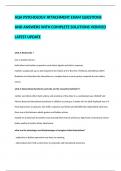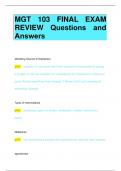Exam (elaborations)
AQA PSYCHOLOGY ATTACHMENT EXAM QUESTIONS AND ANSWERS WITH COMPLETE SOLUTIONS VERIFIED LATEST UPDATE
- Course
- Institution
AQA PSYCHOLOGY ATTACHMENT EXAM QUESTIONS AND ANSWERS WITH COMPLETE SOLUTIONS VERIFIED LATEST UPDATE what is Reciprocity ? how 2 people interact both infant and mother respond to each others signals and elicit a response mothers usually pick up on and respond to the infants 2/3 of the time ( F...
[Show more]




